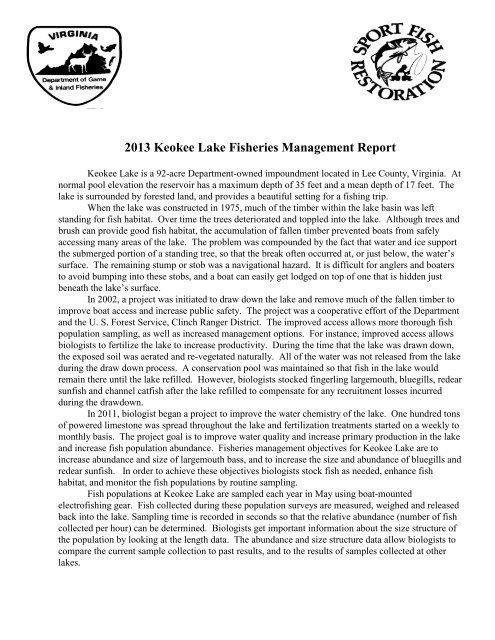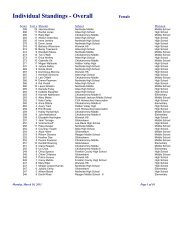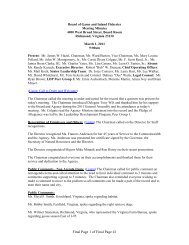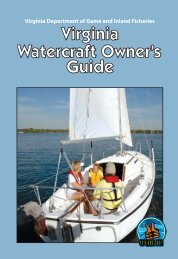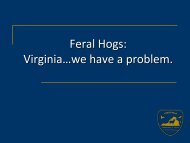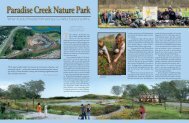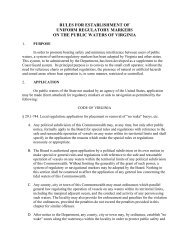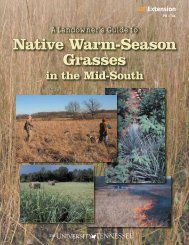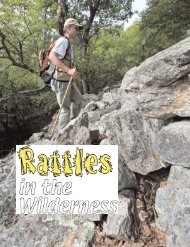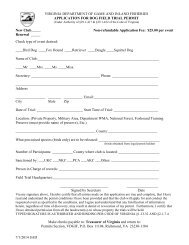Keokee Lake Bio Rpt 2013 - Virginia Department of Game and ...
Keokee Lake Bio Rpt 2013 - Virginia Department of Game and ...
Keokee Lake Bio Rpt 2013 - Virginia Department of Game and ...
Create successful ePaper yourself
Turn your PDF publications into a flip-book with our unique Google optimized e-Paper software.
<strong>2013</strong> <strong>Keokee</strong> <strong>Lake</strong> Fisheries Management Report<strong>Keokee</strong> <strong>Lake</strong> is a 92-acre <strong>Department</strong>-owned impoundment located in Lee County, <strong>Virginia</strong>. Atnormal pool elevation the reservoir has a maximum depth <strong>of</strong> 35 feet <strong>and</strong> a mean depth <strong>of</strong> 17 feet. Thelake is surrounded by forested l<strong>and</strong>, <strong>and</strong> provides a beautiful setting for a fishing trip.When the lake was constructed in 1975, much <strong>of</strong> the timber within the lake basin was leftst<strong>and</strong>ing for fish habitat. Over time the trees deteriorated <strong>and</strong> toppled into the lake. Although trees <strong>and</strong>brush can provide good fish habitat, the accumulation <strong>of</strong> fallen timber prevented boats from safelyaccessing many areas <strong>of</strong> the lake. The problem was compounded by the fact that water <strong>and</strong> ice supportthe submerged portion <strong>of</strong> a st<strong>and</strong>ing tree, so that the break <strong>of</strong>ten occurred at, or just below, the water’ssurface. The remaining stump or stob was a navigational hazard. It is difficult for anglers <strong>and</strong> boatersto avoid bumping into these stobs, <strong>and</strong> a boat can easily get lodged on top <strong>of</strong> one that is hidden justbeneath the lake’s surface.In 2002, a project was initiated to draw down the lake <strong>and</strong> remove much <strong>of</strong> the fallen timber toimprove boat access <strong>and</strong> increase public safety. The project was a cooperative effort <strong>of</strong> the <strong>Department</strong><strong>and</strong> the U. S. Forest Service, Clinch Ranger District. The improved access allows more thorough fishpopulation sampling, as well as increased management options. For instance, improved access allowsbiologists to fertilize the lake to increase productivity. During the time that the lake was drawn down,the exposed soil was aerated <strong>and</strong> re-vegetated naturally. All <strong>of</strong> the water was not released from the lakeduring the draw down process. A conservation pool was maintained so that fish in the lake wouldremain there until the lake refilled. However, biologists stocked fingerling largemouth, bluegills, redearsunfish <strong>and</strong> channel catfish after the lake refilled to compensate for any recruitment losses incurredduring the drawdown.In 2011, biologist began a project to improve the water chemistry <strong>of</strong> the lake. One hundred tons<strong>of</strong> powered limestone was spread throughout the lake <strong>and</strong> fertilization treatments started on a weekly tomonthly basis. The project goal is to improve water quality <strong>and</strong> increase primary production in the lake<strong>and</strong> increase fish population abundance. Fisheries management objectives for <strong>Keokee</strong> <strong>Lake</strong> are toincrease abundance <strong>and</strong> size <strong>of</strong> largemouth bass, <strong>and</strong> to increase the size <strong>and</strong> abundance <strong>of</strong> bluegills <strong>and</strong>redear sunfish. In order to achieve these objectives biologists stock fish as needed, enhance fishhabitat, <strong>and</strong> monitor the fish populations by routine sampling.Fish populations at <strong>Keokee</strong> <strong>Lake</strong> are sampled each year in May using boat-mountedelectr<strong>of</strong>ishing gear. Fish collected during these population surveys are measured, weighed <strong>and</strong> releasedback into the lake. Sampling time is recorded in seconds so that the relative abundance (number <strong>of</strong> fishcollected per hour) can be determined. <strong>Bio</strong>logists get important information about the size structure <strong>of</strong>the population by looking at the length data. The abundance <strong>and</strong> size structure data allow biologists tocompare the current sample collection to past results, <strong>and</strong> to the results <strong>of</strong> samples collected at otherlakes.
Largemouth BassPrior to 2012, largemouth bass relative abundance (number collected per hour <strong>of</strong> sampling)fluctuated between 40 <strong>and</strong> 70 fish per hour (Figure 1). The 2012 sample yielded 182 bass per hour <strong>of</strong>electr<strong>of</strong>ishing. This is an above average abundance for largemouth bass in Southwest <strong>Virginia</strong> lakes<strong>and</strong> double the previous rates. Catch rates for young bass (less than eight inches) have increased sincethe lake was drawn down <strong>and</strong> fertilized. In 2012, the catch rate <strong>of</strong> young bass was 109 per hour. Thenumber <strong>of</strong> young bass collected varies from year to year, because spawning success is better in someyears than others. Catch rates for bass over 12 inches have also improved since the drawdown, liming<strong>and</strong> fertilization project. However, very few bass over 15 inches long have been collected, less than 1%<strong>of</strong> the bass catch in 2012 samples. The largemouth bass fingerlings stocked after the lake refilled werea cross between Florida strain largemouth bass <strong>and</strong> northern strain largemouth bass. These fingerlingswere tagged with a coded wire tag so that they could be identified when collected in routine sampling.After the first growing season, the stocked bass were bigger than bass <strong>of</strong> the same age that werespawned in <strong>Keokee</strong> <strong>Lake</strong>. However, after the second year there were no observed differences ingrowth. Growth was poor for both stocked bass <strong>and</strong> bass spawned naturally in the lake.The slow growth <strong>of</strong> bass in <strong>Keokee</strong> <strong>Lake</strong> results in poor size structure for the bass population.The size structure <strong>of</strong> the bass population improved briefly after the lake refilled, <strong>and</strong> is still better than itwas prior to the drawdown. However, the bass size structure is far from ideal. Growth rates must beimproved in order to improve the quality <strong>of</strong> fish available for anglers. The liming <strong>and</strong> fertilization workstarted in 2012 should improve growth rates as the lake increases fertility. This should increase theabundance <strong>of</strong> plankton <strong>and</strong> provide more forage for young bass <strong>and</strong> the bluegills that larger bass needfor prey.20018018216014012010080677369 7260403545 45402002000 2001 2005 2006 2007 2008 2009 2011 2012Figure 1. Number <strong>of</strong> largemouth bass collected per hour <strong>of</strong> sampling in <strong>Keokee</strong> <strong>Lake</strong> 2000-2012.
SunfishCatch rates for bluegill <strong>and</strong> redear sunfish improved substantially in 2012 (Figure 2). Somequality <strong>and</strong> preferred-size sunfish were collected during sampling. Anglers frequently report catchinglarge bluegills <strong>and</strong> redears. Both bluegills <strong>and</strong> redear sunfish should be able to reproduce naturally inthe lake. Stocking has been discontinued to determine if the populations are self-sustaining.160140120141153BluegillRedear sunfish1191401008078859884604020044252326241790 152000 2001 2005 2006 2007 2008 2009 2011 2012Figure 2. Number <strong>of</strong> bluegill (blue columns) <strong>and</strong> number <strong>of</strong> redear sunfish (red columns) collected perhour <strong>of</strong> electr<strong>of</strong>ishing at <strong>Keokee</strong> <strong>Lake</strong> from 2000 through 2012.CrappieBlack crappie were first collected at <strong>Keokee</strong> <strong>Lake</strong> in the 2005 electr<strong>of</strong>ishing sample. Crappiemay have been present prior to 2005, but undetected by electr<strong>of</strong>ishing because much <strong>of</strong> the shorelinewas inaccessible. Catch rates increased from 2005 to 2008, but have declined since then (Figure 3). Nocrappie were collected in 2009, 2011, <strong>and</strong> only 2 were collected in 2012. The data suggest that crappieare not abundant <strong>and</strong> have sustained low population numbers. Crappie abundance will be monitored aswater quality increases.
35333025202015105050 000 022000 2001 2005 2006 2007 2008 2009 2011 2012Figure 3. Number <strong>of</strong> black crappie collected per hour <strong>of</strong> sampling in <strong>Keokee</strong> <strong>Lake</strong> 2000-2012.In summary, <strong>Keokee</strong> <strong>Lake</strong> <strong>of</strong>fers decent fishing for largemouth bass, bluegills <strong>and</strong> redearsunfish. Most <strong>of</strong> the fish caught will be small. Some larger individual fish are present, especiallybluegills <strong>and</strong> redear sunfish, <strong>and</strong> may provide a memorable day for the lucky or skillful angler.<strong>Bio</strong>logists are deeply concerned about the poor quality <strong>of</strong> the fishery <strong>and</strong> are determined to find asolution. The partial drawdown, <strong>and</strong> subsequent removal <strong>of</strong> st<strong>and</strong>ing <strong>and</strong> fallen trees around theshoreline, improved navigability but did not provide long term improvements to the fishery. In 2011 anew project was launched to begin a liming <strong>and</strong> fertilization program to improve the basic productivity<strong>of</strong> the lake. All fish species are benefiting from increased productivity.Prepared by: George Palmer, Fisheries <strong>Bio</strong>logist with the <strong>Virginia</strong> <strong>Department</strong> <strong>of</strong> <strong>Game</strong> <strong>and</strong>Inl<strong>and</strong> Fisheries: (276) 783-4860; george.palmer@dgif.virginia.gov


